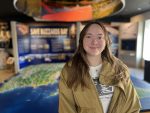Staff Spotlight: Devon Bolt
Devon Bolt, student at Northeastern University, reflects on her time as a Research Assistant with the Coalition as part of Northeastern’s Co-Op program.
 BBC: How long did you work with us at the Coalition, and what was your official job title?
BBC: How long did you work with us at the Coalition, and what was your official job title?
DB: I worked at Buzzards Bay Coalition from late June to mid December (June 26th-Dec 19th) as a Research Assistant
BBC: How did you come to find out about the Coalition and the position?
DB: I grew up in Lakeville, MA and remember seeing signs with the BBC logo often. However, I really found out what the Coalition is and everything it does when I found the position. I go to Northeastern University in Boston where we have a co-op program. This is where we work full time for 6 months instead of a semester of classes to gain undergraduate career experience. We have a Northeastern only job search portal where employers that know about our co-op programs, can post job opportunities. This is where I found and applied to the Salt Marsh Research Assistant position posted by the Coalition.
BBC: Can you briefly summarize the research you did regarding crabs in the marshes?
DB: After working in the salt marshes every day for 3 months, I started to learn what was normal and what wasn’t. That’s why we immediately realized there was a problem at the Little Bay marsh of Fairhaven, MA. There were intense bare patches along creeks and our runnel project channels that were covered in crab burrows. Sesarma crabs are native nocturnal herbivores that feed on the marsh grass. We designed an experiment to test if there was a higher abundance of Sesarma crabs in these bare die-off zones, compared to healthy, fully vegetated zones, to see if the crabs were the culprits to the degradation. To do this we set 30 pitfall crab traps in total between 3 test locations, as well as counting burrows and Sesarma grazed stems. Our results showed in total there were more Sesarma in the die-off zones as well as more burrows and clipped stems in die-off zones. This suggests that these crabs were contributing to the bare patches in our study areas.
BBC: What did your day-to-day work look like?
DB: In the summer, it was extensive field work every day on a team with 2 other people. We would go to one of our 13 marsh sites to collect either elevation, vegetation and fauna, or crab trapping data. Since September, I’ve been doing mostly data QA/QC, which is when I go through all of the past 5 years of data and use excel and R coding to complete a series of checks making sure everything was entered correctly and has the right information. I also use R to make some conceptualization graphs which help to see if there were drastic changes between years. And from September-November there were quite a few field days mixed in with my data days.
BBC: Any projects or moments from your time here that are a particular highlight?
DB: Towards the end of the summer we had what we call “Runnel Week.” This was when all the salt marsh staff, including people who had to fly in or work at different organizations, were called in to help us gain copious amounts of data in a one week period. The week itself was a test of resilience, but it was where I first met my new friend Rosie Hazelton. She was a graduate student (also from Northeastern!!) working at Woodwell who was asked to help for runnel week. We were both here until after the usual internship length so we did field work together until the end of her contract. I helped out on her masters thesis project and learned a whole new set of techniques including sediment trapping, erosion blocks, and litter bags. We took turns helping each other on our respective field responsibilities which is also how she helped me with the Sesarma research experiment. I got to learn a diverse variety of new information and found a close friend simultaneously.
BBC: What have you learned from your time with the Coalition, and how do you think your experience will inform your career in the future?
DB: I learned so much at the Coalition and from my boss, Rachel Jakuba. In addition to the scientific techniques and procedures I mentioned above, I learned how to keep a positive attitude on long, blistering hot field days. We had to be completely independent in the field other than one training day for each technique. This made us learn how to work on a team efficiently and focus on getting the data as accurate as possible without supervision. I learned how to research and conduct an experiment. As well as learning the procedure to data QA/QC and how tedious you must be to catch errors in rows and rows of data. The staff meetings were so interesting and I loved learning what was going on in all the other departments and how they came together to make the Coalition as a whole. Most importantly, I learned how much effort, time, and resources the Buzzards Bay Coalition puts into protecting, and restoring our local environment.
BBC: What is your favorite Buzzards Bay “hidden gem”?
DB: One day after I was working out of the Marion office, I found this cafe called the Bluefoot Cafe. It’s Blue-footed Booby themed (the bird) and has amazing local coffee, food, and is decorated beautifully. I’ll also give their acai bowls their own shout out because they are delicious and use sunbutter so people with nut allergies (like me) can enjoy them!